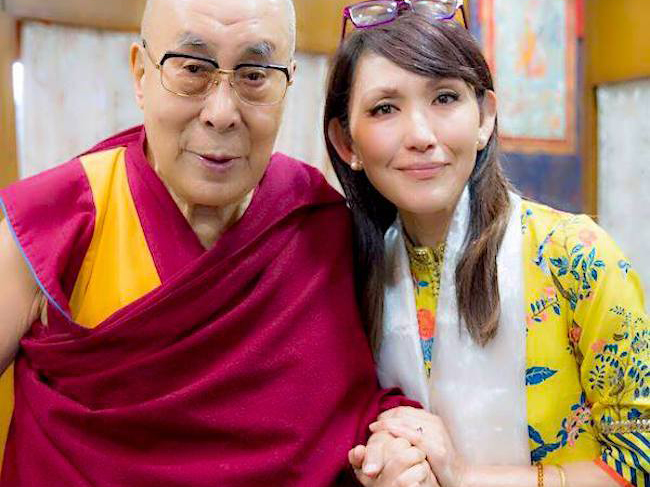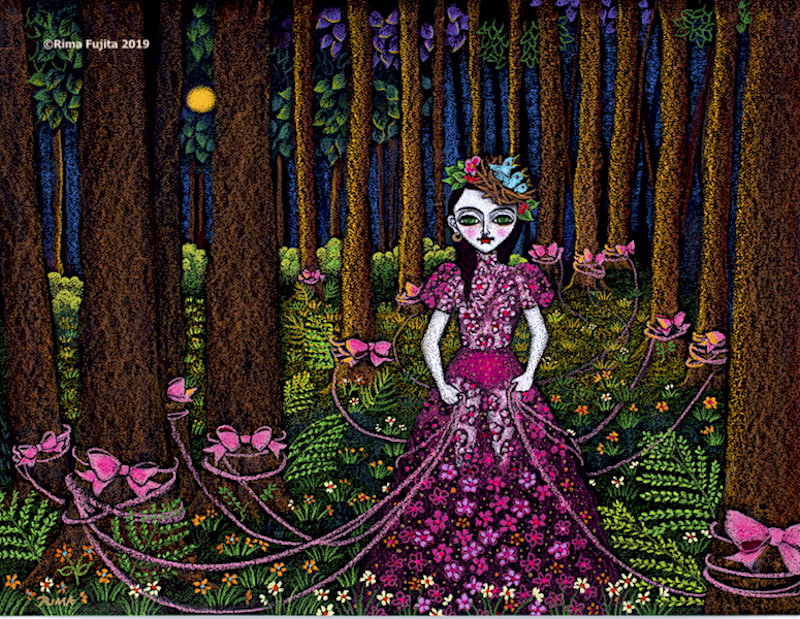
“We live in a world where superficial beauty is valued, and materialism is worshipped,” says artist Rima Fujita. “How do you stay calm and find real happiness? How do you stop comparing yourself to others, stay focused on your path and find goodness and satisfaction in your life?”
These questions inspired Fujita to create a series of vibrant, dreamlike paintings on show November 6-12 at Isetan Art Gallery in Shinjuku. Titled “Marga,” which means “path” in Sanskrit, the series invites reflection on our path as individuals and as a society.
Born in Tokyo, Fujita moved with her parents to New York City at 15 and is now based in Los Angeles. She’s not only passionate about making a difference through art, but through philanthropic activities focused on creativity, community and what we can do to contribute to our own and others’ well-being.
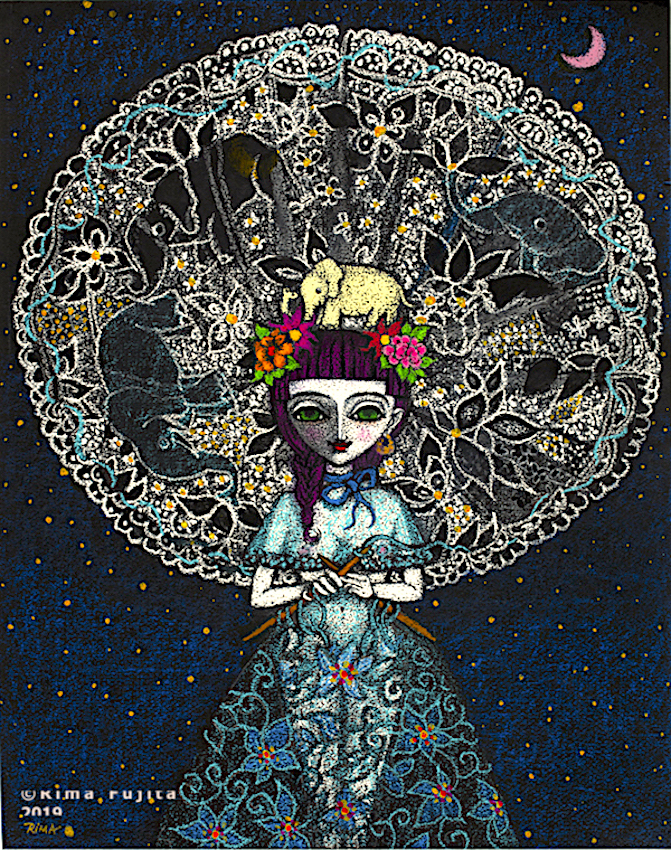
Time ©RimaFujita
How did you become an artist?
I was an only child and spent a lot of time drawing alone. By first grade, I was already sketching things around me. I didn’t speak English well when I moved to New York, so I spent lots of time in the art studio at my high school. I made a few friends through art, and art gave me confidence. I attended Parsons School of Design and from my senior year was already getting illustration jobs for fashion magazines. After graduation, I became a full-time artist. I had a fortunate start, as I was selling well and making a good living in my twenties.
Why did you choose painting?
I love color, so painting was the most exciting form of art for me.
How would you describe your work?
Spiritual, ethereal and dreamy – rooted in strong themes.
How do you develop your images and themes?
I paint the dreams I have during sleep. I also paint the visions I see during meditation. It’s rather strange, but this is how I work.
Theme comes through intuition. Usually it’s something I’ve been thinking about, or am going through in my life at that moment.
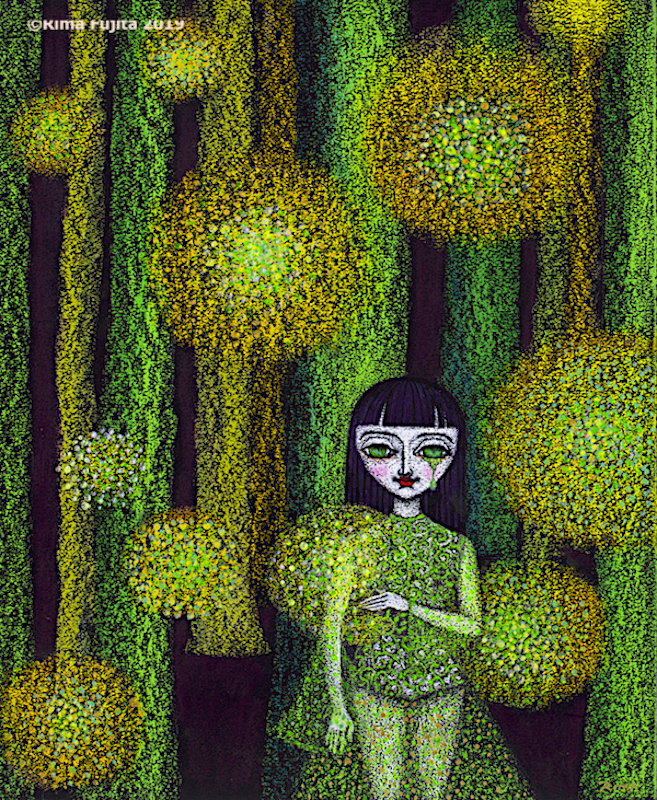
Silence Between the Space ©RimaFujita
You’ve said you’re influenced by Bushido and Buddhism. In what way?
My ancestors were the last samurais and I grew up hearing about how dignified they were, so the samurai ethic is my work ethic. I try my best to respect everything involved with my art: how I paint, the tools, collectors, galleries, museums; the media and publishers. We are all interdependent. We must take pride in what we do, and do it with respect and honor. This is very important.
Describe a typical day.
I wake up and do a short affirmation. Go for a walk. Have an early lunch, meditate, then paint for the rest of the afternoon. In the evening, I walk my pug, make dinner, catch up with my husband Paul, then go to bed. I don’t paint at night because I only work with natural light.
What’s most challenging for you as an artist?
The business side. I don’t like dealing with aggressive art dealers. I don’t enjoy the art world in general. I’ve had “Me, too” experiences, had my work stolen by dealers, not gotten paid for my paintings, just to name a few things. Though I was selling well in my twenties, I saw so much greed and dishonesty in the art world. I knew I didn’t want to be part of that world but didn’t know what to do about it.
However, in my twenty-six years as an artist, I’ve created a good balance, exhibiting and selling my work to collectors, museums, and galleries I enjoy collaborating with.
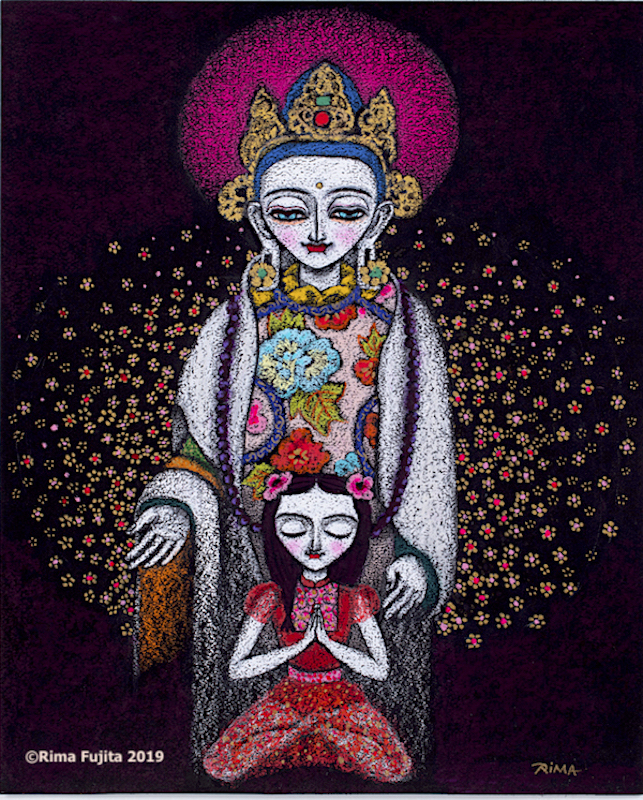
Bodhisattva ©RimaFujita
What are your current projects?
Two murals in Los Angeles for an animal sanctuary, and a picture book of the Dalai Lama’s life story that will be published in fall 2021.
How did you become involved in Tibet-related work?
One night in the 1990s, I heard a commanding voice in my dream say, “Help Tibet now!” I didn’t know anything about Tibet and didn’t even know who the Dalai Lama was! So I spent all day at the New York Public Library and found out about the tragedy of Tibet since the Chinese occupation. Then strangely, I began meeting Tibetans. One day I was talking with my first Tibetan friend, and he told me that as a refugee in South India he lived in a tent, had no food, absolutely nothing. Then I got this idea to create a picture book of Tibetan stories and donate it to the Tibetan refugees in exile. I started an organization called “Books for Children” and have created seven picture books and donated 15,000 books to Tibetan refugees. The goal is to help preserve Tibet’s unique culture and language.
Last March, I interviewed the Dalai Lama at his residence in Dharamsala, India for T Japan: The New York Times Style Magazine. I was given fifteen minutes by the secretary, but the Dalai Lama spent almost one hour with me. He offered me the best chai I’d ever tasted! I got really nervous beforehand, but in his presence, I felt so calm, comfortable, and peaceful. His focus is extraordinary. I’ve never met anyone like him – when he talks to you, he pays 120% attention and makes you feel as if you’re the only person who exists on this earth.
What experience has had the most impact on you?
My encounters with Tibetan refugees and meeting the Dalai Lama. Tibet, the Tibet cause, has changed my life as an artist and as a person. I was young and successful but didn’t know why I was creating art. After the voice in my dream told me to help Tibet, I realized my art was not a “goal,” a way to gain money and fame, but a means of contributing to society and humanity. This revelation gave me a true purpose in creating art and a sense of liberation from the greedy art world.
What’s the biggest lesson you’ve learned in life?
You are the master of your own life. You cannot keep blaming others for your discontent. You create your own happiness, no one else.
If you weren’t an artist, what would you be?
Someone who helps people who are suffering, and/or someone who can invent new technology to save this planet.
Who do you most admire?
A person who has true peace and happiness within. Buddha. The Dalai Lama.
Find details about Rima Fujita’s upcoming exhibition “Marga” (November 6–12, 2019) at rimafujita.com
Feature image: TreeKeeper ©RimaFujita

